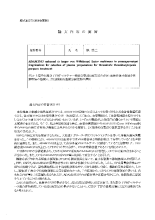ADAMTS13 unbound to larger von Willebrand factor multimers in cryosupernatant: Implications for selection of plasma preparations for TTP treatment クリオ上清中の高分子VWFマルチマー非結合型ADAMTS13の存在:血栓性血小板減少性紫斑病の治療に、より効果的な血漿分画製剤の選択
この論文にアクセスする
著者
書誌事項
- タイトル
-
ADAMTS13 unbound to larger von Willebrand factor multimers in cryosupernatant: Implications for selection of plasma preparations for TTP treatment
- タイトル別名
-
クリオ上清中の高分子VWFマルチマー非結合型ADAMTS13の存在:血栓性血小板減少性紫斑病の治療に、より効果的な血漿分画製剤の選択
- 著者名
-
Hori, Yuji
- 著者名
-
Hayakawa, Masaki
- 著者名
-
Isonishi, Ayami
- 著者名
-
Soejima, Kenji
- 著者名
-
Matsumoto, Masanori
- 著者名
-
Fujimura, Yoshihiro
- 学位授与大学
-
奈良県立医科大学
- 取得学位
-
博士(医学)
- 学位授与番号
-
乙第1322号
- 学位授与年月日
-
2013-11-27
注記・抄録
BACKGROUND: Thrombotic thrombocytopenic purpura (TTP) is characterized by deficient ADAMTS13 activity. Treatment involves plasma exchange (PE). Both fresh-frozen plasma (FFP) and cryosupernatant (CSP) are used, but it remains to be determined which is more effective.STUDY DESIGN AND METHODS: To analyze the interaction between von Willebrand factor (VWF) and ADAMTS13, we used large-pore isoelectric focusing (IEF) analysis followed by detection with anti-ADAMTS13 monoclonal antibody. FFP, CSP, cryoprecipitate (CP), and purified ADAMTS13 were analyzed for their effects on high shear stress-induced platelet aggregation (H-SIPA).RESULTS: IEF analysis of normal plasma revealed three groups of ADAMTS13 bands with pI of 4.9 to 5.6, 5.8 to 6.7, and 7.0 or 7.5. Two band groups (pI 4.9-5.6 and 5.8-6.7) were found in plasma of a patient with Type 3 von Willebrand disease, in which VWF is absent, whereas no bands were found in plasma of a patient with congenital ADAMTS13 deficiency. Mixing these plasmas generated the bands at pI 7.0 or 7.5, representing the VWF-ADAMTS13 complex; these bands were absent in CSP. FFP and purified ADAMTS13 down regulated H-SIPA in a dose-dependent manner. However, CP did not inhibit H-SIPA in the initial phase, and the degree of inhibition at the endpoint was almost indistinguishable from those of the other two plasma products.CONCLUSION: Both plasma products (FFP and CSP) are effective for PE in TTP patients. However, CSP may be more favorable, because it has lower levels of VWF and almost normal ADAMTS13 activity, but lower levels of ADAMTS13 in complex with larger VWF multimers.
博士(医学)・乙第1322号・平成25年11月27日
© 2013 American Association of Blood Banks
Copyright © 1999-2018 John Wiley & Sons, Inc. All rights reserved
This is the pre-peer reviewed version of the following article: [https://onlinelibrary.wiley.com/doi/full/10.1111/trf.12182], which has been published in final form at [http://dx.doi.org/10.1111/trf.12182]. This article may be used for non-commercial purposes in accordance with Wiley Terms and Conditions for Use of Self-Archived Versions.
identifier:Transfusion Vol.53 No.12 p.3192–3202
identifier:00411132
identifier:http://ginmu.naramed-u.ac.jp/dspace/handle/10564/2677
identifier:Transfusion, 53(12): 3192-3202
開始ページ : 3192
終了ページ : 3202
BACKGROUND: Thrombotic thrombocytopenic purpura (TTP) is characterized by deficient ADAMTS13 activity. Treatment involves plasma exchange (PE). Both fresh-frozen plasma (FFP) and cryosupernatant (CSP) are used, but it remains to be determined which is more effective. STUDY DESIGN AND METHODS: To analyze the interaction between von Willebrand factor (VWF) and ADAMTS13, we used large-pore isoelectric focusing (IEF) analysis followed by detection with anti-ADAMTS13 monoclonal antibody. FFP, CSP, cryoprecipitate (CP), and purified ADAMTS13 were analyzed for their effects on high shear stress-induced platelet aggregation (H-SIPA). RESULTS: IEF analysis of normal plasma revealed three groups of ADAMTS13 bands with pI of 4.9 to 5.6, 5.8 to 6.7, and 7.0 or 7.5. Two band groups (pI 4.9-5.6 and 5.8-6.7) were found in plasma of a patient with Type 3 von Willebrand disease, in which VWF is absent, whereas no bands were found in plasma of a patient with congenital ADAMTS13 deficiency. Mixing these plasmas generated the bands at pI 7.0 or 7.5, representing the VWF-ADAMTS13 complex; these bands were absent in CSP. FFP and purified ADAMTS13 down regulated H-SIPA in a dose-dependent manner. However, CP did not inhibit H-SIPA in the initial phase, and the degree of inhibition at the endpoint was almost indistinguishable from those of the other two plasma products. CONCLUSION: Both plasma products (FFP and CSP) are effective for PE in TTP patients. However, CSP may be more favorable, because it has lower levels of VWF and almost normal ADAMTS13 activity, but lower levels of ADAMTS13 in complex with larger VWF multimers.
